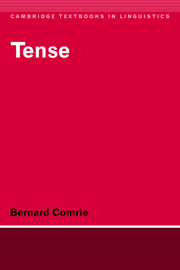2 - Absolute tense
Published online by Cambridge University Press: 05 June 2012
Summary
The term absolute tense is a traditional, though somewhat misleading term, that has come to be used to refer to tenses which take the present moment as their deictic centre. The term is misleading because, strictly speaking, absolute time reference is impossible, since the only way of locating a situation in time is relative to some other already established time point; the present moment is in principle just one of an infinite number of such time points that could be chosen as reference point, although it does play a major role in the definition of tense systems across the languages of the world. There is thus a real sense in which taking the present moment as the deictic centre establishes the most basic tenses cross-linguistically, those in terms of which it is often easier to understand deviations from absolute tense. We shall continue to use the traditional term absolute tense, although it should be borne in mind that this should be interpreted to mean a tense which includes as part of its meaning the present moment as deictic centre; whereas relative tense (chapter 3) refers to a tense which does not include as part of its meaning the present moment as deictic centre.
Given the present moment as deictic centre, it might seem trivial to define the three basic tenses that have formed the backbone of much linguistic work on time reference in grammar, namely present, past and future, as follows: present tense means coincidence of the time of the situation and the present moment; past tense means location of the situation prior to the present moment; future tense means location of the situation after the present moment.
- Type
- Chapter
- Information
- Tense , pp. 36 - 55Publisher: Cambridge University PressPrint publication year: 1985



